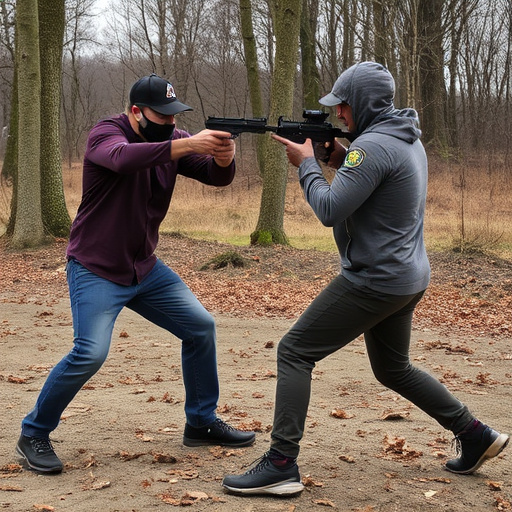Pink Stun Gun Laws: Navigating State Requirements & Safety Features
In many regions, civilian ownership of a pink stun gun with disable pin safety feature is governed b…….
In many regions, civilian ownership of a pink stun gun with disable pin safety feature is governed by state laws with distinct rules and restrictions. These regulations cover age limits, training requirements, permitted taser types, carry methods, and sale/transfer restrictions to ensure safe and responsible use. Understanding these variations across states is crucial for legal acquisition and possession. In the US, federal ATF regulations control stun guns as 'non-firearms', balancing personal and public safety. State laws vary widely in terms of eligible purchase, use scenarios, and carrying restrictions, with some emphasizing safety features like disable pin mechanisms through training and certification. Despite efforts to regulate access, challenges remain, creating confusion and potential misuse. Future regulations may include stricter guidelines, enhanced training, and smart technologies for improved user safety.
“Exploring the legal landscape of civilian taser ownership, with a focus on the stringent requirements for acquiring a pink stun gun, is essential given the growing interest in personal defense tools. This article delves into state laws, federal regulations, and unique considerations surrounding ‘pink guns’ equipped with disable pin safety features. From understanding legal perspectives to addressing common challenges, it offers a comprehensive guide for those seeking knowledge about civilian taser ownership. Additionally, we examine future trends, ensuring you’re informed about the evolving regulatory environment.”
- Understanding Civilian Taser Ownership: A Legal Perspective
- Federal Laws and Regulations Surrounding Stun Guns
- State-Specific Requirements for Purchasing a Pink Stun Gun
- The Role of Disable Pin Safety Features in Legal Considerations
- Common Challenges and Loopholes in Taser Ownership Laws
- Future Trends and Changes in Civilian Taser Regulation
Understanding Civilian Taser Ownership: A Legal Perspective

In many jurisdictions, civilian taser ownership is regulated under state laws, each with its unique set of requirements and restrictions. Understanding these legal perspectives is crucial for individuals considering acquiring a pink stun gun with disable pin safety feature for self-defense purposes. The regulations often cover eligibility criteria, such as age restrictions and necessary training, to ensure safe and responsible use.
State laws may also delineate the types of tasers permissible for civilian ownership, including specific models or power levels, and dictate where and how these devices can be carried. Some states allow open carry, while others require concealed carry permits. Additionally, there are often restrictions on the sale and transfer of tasers to ensure that only qualified individuals gain access to such devices, enhancing public safety in the event of accidental or unauthorized use.
Federal Laws and Regulations Surrounding Stun Guns

In the United States, the federal government has implemented regulations to control the sale and possession of stun guns, often referred to as Tasers. These laws aim to balance personal safety with public safety concerns. The Federal Bureau of Alcohol, Tobacco, Firearms, and Explosives (ATF) is the primary regulatory body overseeing the distribution and ownership of stun devices. One key aspect is the distinction between stun guns and firearms, ensuring that individuals can legally acquire and carry non-lethal self-defense tools like pink stun guns with disable pin safety features.
The ATF categorizes stun guns as ‘non-firearm’ if they meet specific criteria, allowing them to be sold and possessed without the same stringent requirements as firearms. These devices must use electricity or other energy sources for their primary function and have a means of preventing discharge unless intentionally activated by the user. This classification ensures that responsible citizens can protect themselves without navigating complex legal procedures often associated with firearm ownership.
State-Specific Requirements for Purchasing a Pink Stun Gun

In many US states, the purchase and ownership of a pink stun gun with a disable pin safety feature is regulated by specific laws designed to ensure public safety. Before considering civilian taser ownership, it’s crucial to understand these state-specific requirements. Each state has its own set of rules regarding which types of stun guns are legal, who can buy them, and under what circumstances they can be used.
For example, some states may restrict the sale of pink stun guns to individuals over a certain age or require a background check. Others might mandate safety training or registration for first-time buyers. Additionally, there could be restrictions on where these devices can be carried—for instance, in schools, courthouses, or other public places—and how they can be used without facing legal repercussions. Understanding and adhering to these regulations is essential for responsible civilian ownership of a pink stun gun with a disable pin safety feature.
The Role of Disable Pin Safety Features in Legal Considerations

The legal landscape surrounding civilian tasers is intricate, with state laws varying widely in their regulations and requirements for ownership. One notable aspect often considered in these discussions is the role of safety features designed to disable or de-escalate situations, such as those found in a pink stun gun with disable pin safety feature. These innovative tools are increasingly favored by individuals seeking personal protection, but their integration into state laws remains uneven.
In many jurisdictions, the presence of disable pin safety mechanisms is not only encouraged but also mandated for civilian taser owners. This is because such features promote responsible use by ensuring that the device cannot be activated accidentally or without intention, thereby reducing potential harm to oneself and others. As a result, states with stricter regulations often require training and certification for individuals seeking to purchase and carry pink stun guns equipped with these safety pins, adding an extra layer of responsibility and knowledge to the ownership process.
Common Challenges and Loopholes in Taser Ownership Laws

Despite efforts to regulate civilian access to tasers, several challenges and loopholes persist in state laws, leaving room for potential misuse. One notable issue is the variety in definitions and requirements for what constitutes a taser, with some states having broad interpretations that may include non-lethal self-defense devices, while others have specific and limited criteria. This variability can create confusion among prospective buyers, especially those seeking reliable personal protection tools like a pink stun gun with disable pin safety feature.
Furthermore, the legal framework around taser ownership often contains gaps. Some states lack clear guidelines on waiting periods or background checks for purchases at private sales, making it easier for individuals with criminal records to acquire tasers. Additionally, there may be insufficient penalties for misuse or unauthorized possession, potentially encouraging irresponsible ownership. These challenges underscore the need for more uniform and stringent regulations to ensure that civilian taser ownership is both safe and responsible.
Future Trends and Changes in Civilian Taser Regulation

The regulation of civilian taser ownership is an evolving area, with new developments and trends emerging in response to technological advancements and societal changes. One notable trend is the increasing emphasis on safety features, such as disable pins and easy-to-use designs. These innovations cater to the growing demand for non-lethal self-defense options while ensuring user safety. For instance, some modern pink stun guns incorporate these disable pin safety features, providing users with a balance between protection and control.
Looking ahead, it’s foreseeable that stricter guidelines and more comprehensive training requirements will be implemented as technology advances further. This shift could involve enhanced regulation of high-voltage devices, including tasers, to prevent misuse and ensure public safety. Additionally, the integration of smart technologies, such as GPS tracking and automated deactivation mechanisms, may become mandatory in certain jurisdictions, allowing for better oversight and accountability.
In conclusion, navigating the legal landscape of civilian taser ownership, particularly focusing on state-specific requirements for pink stun guns equipped with disable pin safety features, is essential for responsible individuals seeking self-defense options. Understanding federal regulations and identifying common challenges in taser ownership laws is crucial for ensuring compliance and public safety. As these laws continue to evolve, staying informed about future trends will help maintain a balanced approach to civilian taser regulation.


